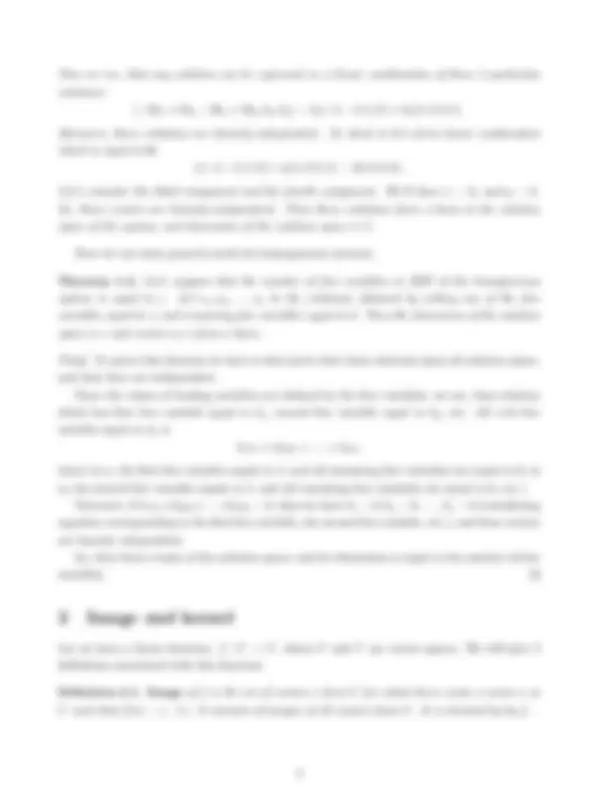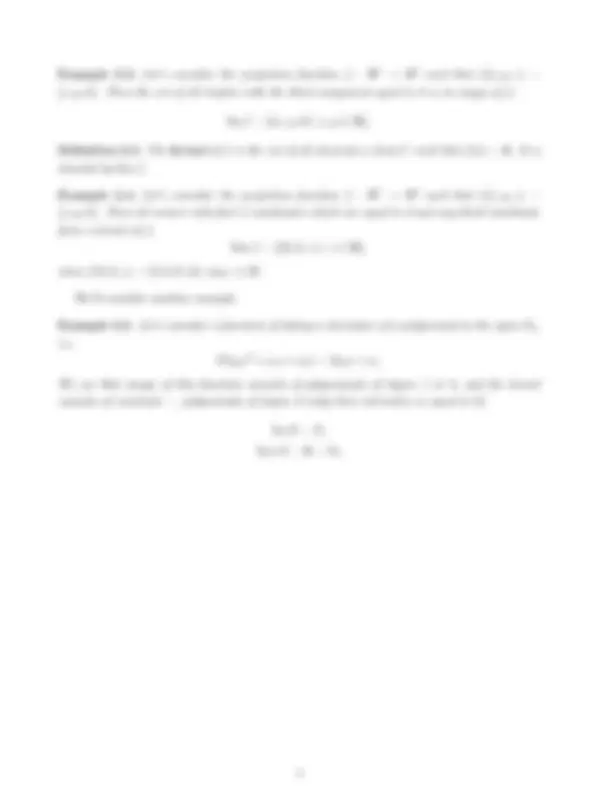




Study with the several resources on Docsity

Earn points by helping other students or get them with a premium plan


Prepare for your exams
Study with the several resources on Docsity

Earn points to download
Earn points by helping other students or get them with a premium plan
Community
Ask the community for help and clear up your study doubts
Discover the best universities in your country according to Docsity users
Free resources
Download our free guides on studying techniques, anxiety management strategies, and thesis advice from Docsity tutors
The properties of homogeneous systems in linear algebra. Homogeneous systems are systems with zero values on the right-hand side. The document proves that the solution set of a homogeneous system forms a vector space. Examples and theorems to illustrate the concepts.
Typology: Study notes
1 / 4

This page cannot be seen from the preview
Don't miss anything!



Last time we studied linear functions. To continue our theory about them we have to study another topic, which we will use in our future lectures. Recall, that the system is called homogeneous, if it has 0’s in the right hand side. The main fact about them is that each homogeneous system has either 1 or infinitely many solutions; moreover, if the number of equations is less than the number of variables, then the system has infinitely many solutions. We’ll state some properties of the solution set of the homogeneous system.
Existence of 0. (0, 0 ,... , 0) is a solution.
Addition of solutions. Let we have 2 solutions of the homogeneous system, (y 1 , y 2 ,... , yn) and (y′ 1 , y 2 ′,... , y n′). Then (y 1 + y′ 1 , y 2 + y′ 2 ,... , yn + y n′) is a solution. To check it consider an equation of the system:
ai 1 x 1 + ai 2 x 2 + · · · + ainxn = 0.
Since specified n-tuples are solutions, we have:
ai 1 y 1 + ai 2 y 2 + · · · + ainyn = 0 and ai 1 y′ 1 + ai 2 y 2 ′ + · · · + ainy n′ = 0.
Adding these 2 equations, we have:
ai 1 (y 1 + y′ 1 ) + ai 2 (y 2 + y 2 ′) + · · · + ain(yn + y′ n) = 0,
so, (y 1 + y′ 1 , y 2 + y 2 ′,... , yn + y′ n) is a solution.
Multiplication by a number. Let (y 1 , y 2 ,... , yn) be a solution. Then (cy 1 , cy 2 ,... , cyn) is a solution. To check it consider an equation of the system:
ai 1 x 1 + ai 2 x 2 + · · · + ainxn = 0.
Since specified n-tuples are solutions, we have:
ai 1 y 1 + ai 2 y 2 + · · · + ainyn = 0
Multiplying equation by c, we get
ai 1 (cy 1 ) + ai 2 (cy 2 ) + · · · + ain(cyn) = 0,
so (cy 1 , cy 2 ,... , cyn) is a solution.
So we see, that for any 2 solutions their sum is also a solution, zero is a solution, and for any solution, constant multiplied by this solution is a solution. So, we get the following theorem:
Theorem 1.1. The solution set of the homogeneous system is a vector space.
Let’s analyze this vector space. I.e. we would like to find its dimension and basis. First we will show it in the example.
Example 1.2. Consider the following system:
x 1 + 2 x 2 − x 3 + 2 x 4 = 0 2 x 1 + 5 x 2 + x 3 − x 4 = 0 3 x 1 + 7 x 2 + x 4 = 0
Let’s try to solve it. Subtracting the first equation from the second one and the third one we get: (^)
x 1 + 2 x 2 − x 3 + 2 x 4 = 0 x 2 + 3 x 3 − 3 x 4 = 0 x 2 + 3 x 3 − 3 x 4 = 0
and the third equation is redundant. Free variables in this system are x 3 and x 4. Assigning values x 3 = k 3 and x 4 = k 4 we have:
x 2 = − 3 k 3 + 3k 4 x 1 = − 2 x 2 + x 3 − 2 x 4 = 2(− 3 k 3 + 3k 4 ) + k 3 − 2 k 4 = − 5 k 3 + 4k 4.
So, the solution set is:
{(− 5 k 3 + 4k 4 , − 3 k 3 + 3k 4 , k 3 , k 4 ) | k 3 , k 4 ∈ R}
Let’s get 2 particular solutions by assigning first k 3 = 1, k 4 = 0, and then k 3 = 0, k 4 = 1.
Example 2.2. Let’s consider the projection function f : R^3 → R^3 such that f (x, y, z) = (x, y, 0). Then the set of all triplets with the third component equal to 0 is an image of f :
Im f = {(x, y, 0) | x, y ∈ R}.
Definition 2.3. The kernel of f is the set of all elements u from U such that f (u) = 0. It is denoted by Ker f.
Example 2.4. Let’s consider the projection function f : R^3 → R^3 such that f (x, y, z) = (x, y, 0). Then all vectors with first 2 coordinates which are equal to 0 and any third coordinate form a kernel of f. Ker f = {(0, 0 , z) | z ∈ R},
since f (0, 0 , z) = (0, 0 , 0) for any z ∈ R.
We’ll consider another example.
Example 2.5. Let’s consider a function of taking a derivative of a polynomial in the space P 2 , i.e. D(a 2 x^2 + a 1 x + a 0 ) = 2a 2 x + a 1.
We see that image of this function consists of polynomials of degree 1 or 0, and the kernel consists of constants — polynomials of degree 0 (only their derivative is equal to 0):
Im D = P 1 Ker D = R = P 0